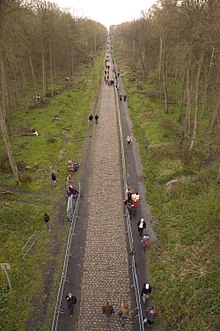Trouée d'Arenberg
The Trouée d'Arenberg or Tranchée d'Arenberg to German, the swath of Arenberg , often called the Forest of Arenberg referred to a 2400 meters long, straight, with is cobblestone paved forest path in the field of community Wallers (district Arenberg) in French North department . It has been used in the Paris – Roubaix cycle race since 1969 and has been a symbol of this cobblestone classic ever since. At the same time listed is Trouée d'Arenberg probably the most famous passage of a one-day race of the cycling .
Characteristic
The Trouée d'Arenberg is assigned the highest level of difficulty in the Paris-Roubaix cycle race with five stars together with the cobblestone passages Mons-en-Pévèle and Carrefour de l'Arbre . The particular challenge is due to the irregularity of the paving stones. In order to prevent drivers from evading the cobblestones, the adjacent hard shoulder is usually plowed or blocked by barriers.
Although the Trouée d'Arenberg is almost 100 km from the finish in Roubaix , this cobblestone section has a decisive character. The previously mostly existing main field is divided into several groups due to the difficulty of the passage. Technical breakdowns and falls are also inevitable. Drivers who cannot follow the pace of the favorites or who crash have hardly any chance of being able to decisively intervene in the outcome of the race. Not least because the team vehicles are not allowed to drive on this section.
history
The Trouée d'Arenberg, which is officially called "La Drève des Boules d'Hérin" ( ball alley from Hérin ), was proposed in 1968 by professional cyclist Jean Stablinski for inclusion in the Paris-Roubaix cycling race. The cycling world champion from 1962 knew this path because he had worked as a miner on the neighboring Arenberg colliery ( fosse Auguste d'Arenberg ) in Wallers before his professional career and was therefore familiar with the area. He used to say that he was the only professional cyclist who knew the route both underground and surface. There is also a memorial stone in his honor at the exit of the Trouée d'Arenberg.
The line was closed from 1974 to 1983, but since then, with the exception of 2005, has been an integral part of Paris-Roubaix again. After a serious accident by World Cup leader Johan Museeuw in 1998, the Trouée d'Arenberg was modified several times. Since 1999, the route has been used in the opposite direction, overcoming a small difference in altitude in order to reduce the speed. In 2005 the Trouée d'Arenberg was renovated for 250,000 euros and restored to its original width of three meters.
Web links
Coordinates: 50 ° 23 ′ 56.4 " N , 3 ° 24 ′ 45" E

